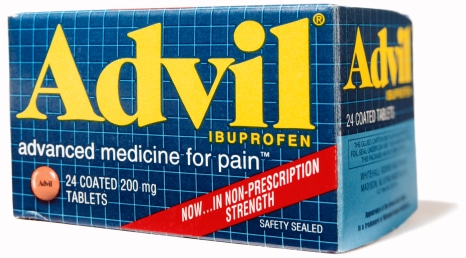 When you feel sore after a workout do you reach for a bottle of Advil? Lots of athletes use non-steroidal anti-inflammatory medications (NSAID) like ibuprofen to relieve aches and pains from working out too hard. Some even take these over-the-counter medications before a hard workout in hopes of preventing soreness afterward. Unfortunately, there are drawbacks to using these medications too often, especially if you work out.
When you feel sore after a workout do you reach for a bottle of Advil? Lots of athletes use non-steroidal anti-inflammatory medications (NSAID) like ibuprofen to relieve aches and pains from working out too hard. Some even take these over-the-counter medications before a hard workout in hopes of preventing soreness afterward. Unfortunately, there are drawbacks to using these medications too often, especially if you work out.
How Do NSAID Work?
NSAID work by blocking the action of cyclooxygenase enzymes called COX isoenzymes. These isoenzymes are important for the synthesis of prostaglandins, compounds that play a role in inflammation and in reactions that affect a variety of organs including the heart, digestive system, and kidneys. Blocking these enzymes is beneficial for relieving muscle aches and pains caused by inflammation, but, unfortunately, blocking them has effects on other areas of the body.
Health Risks of NSAID
Prostaglandins are important for maintaining the protective mucous lining that protects your stomach against acid. That’s why people who take NSAID regularly increase their risk of ulcers and intestinal bleeding. Taking them long term can also damage the delicate lining of the small intestine and allow breakdown products of foods that are normally absorbed to be released into the bloodstream. This can trigger an immune response that leads to the symptoms of leaky gut syndrome.
Prostaglandins also help to maintain blood flow to the kidneys. When you take NSAID, blood flow to your kidneys is reduced. This increases the risk of kidney problems, although this is less likely to be a problem if you drink enough fluids during exercise. According to an article published in The New York Times, some of the runners in the Western States Endurance Race, a 100-mile long ultra-marathon who took ibuprofen before and during the race had evidence of reduced kidney function after they finished. If you take NSAID such as Advil for even short periods of time, it’s important to stay well-hydrated.
Recent research shows that taking these medications increases the risk of heart attacks and strokes two to fourfold. That’s why prescription NSAIDs Vioxx and Bextra were removed from the market.
They Slow Down Healing of Injuries Too
Another role that prostaglandins play is to increase the synthesis of collagen, a protein that provides support for skin, bones, muscles, tendons, and cartilage. When you take NSAID like ibuprofen, you produce less collagen. That isn’t a good thing if you’re trying to heal an injury involving muscle, bone or tendon. Using NSAID may slow down the healing process.
Another problem with using these medications is they mask pain. Pain is a sign that’s something’s wrong, and if you use ibuprofen to cover it up and keep working out you can do more damage. Some athletes use NSAID to get them through a workout when they should be resting to allow their injury to heal. There’s even evidence that taking these medications may interfere with training adaptations, so your body is less responsive to the training you do. Who wants that?
Should You Take Them at All?
Despite their risks, taking an occasional ibuprofen probably won’t be a problem if you don’t have a history of ulcers and you drink plenty of fluids, but taking them on a daily basis as some athletes do could lead to trouble. Don’t use them before a workout to prevent aches and pains afterward, and don’t use them to work through an injury when you should be resting. Use them only when you really need them and for the shortest time possible. The longer and more frequently you take them, the more likely you are to experience problems.
The Bottom Line?
Non-steroidal anti-inflammatory medications may be freely available over-the-counter, but that doesn’t mean they’re safe, especially if you take them too often. Have a healthy respect for these medications that have an impact on your kidneys, heart, and intestinal tract, and use them only when you have to.
References:
Web MD. “NSAID Pain Relievers Raise Heart Risk”
The New York Times. “Phys Ed: Does Ibuprofen Help or Hurt During Exercise?”
British Journal of Sports Medicine. 43: 548-549, 2009.

